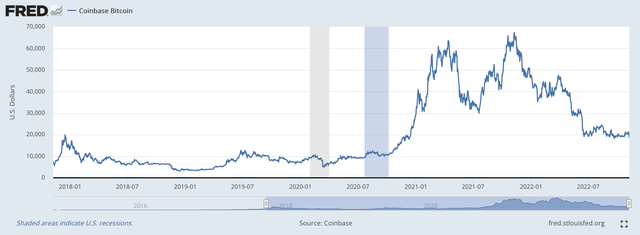DNY59
FTX Crypto Exchange, the shining star of the cryptocurrency world, bit the dust.
FTX has agreed to be acquired by Binance, another star of the crypto world.
We read in The Wall Street Journal,
“The pact marks a victory for Binance founder Changpeng Zhao and a humbling comedown for Sam Bankman-Fried, the founder of FTX, which had been growing in size and recognition before a clash between the two men set off a series of events that shook investor confidence in his firm.”
“The deal signals a power shift in the crypto world, which has been hurt by rising interest rates and investors’ retreat from risk.”
And, who created the environment where there are rising interest rates and an investor retreat from risk?
Well, who else but the Federal Reserve.
So, one could argue that the demise of FTX has been related to the effort of the Federal Reserve to tighten up monetary policy to combat the rapid rate of increase the United States is experiencing in its price level.
And, it appears as if the Federal Reserve will continue this stance well into the near future.
The Buildup
Sam Bankman-Fried founded FTX in 2019 and built the company’s profile by splashing millions on a high-profile media campaign. This included buying the naming rights to the NBA’s Miami Heat arena – now FTX Arena – and appearing in glossing Vogue magazine advertisements with supermodel Gisele Bundchen:
“He also clinched the support of major investors including SoftBank, Tiger Global, BlackRock, and Ontario Teachers’ Pension Plan, which poured money into FTX.”
The collapse came in lightning-fast time.
But, then the build-up came in lightning-fast time, too.
The build-up also came in response to all the money the Federal Reserve was pouring into the United States financial system to combat the spread of the Covid-19 pandemic that was attacking the world in the early 2020s.
From starting up FTX in 2019, the company, at the start of 2022, was valued at $32 billion.
Nothing captures the picture of this build-up of value than the chart on the price of the Coinbase Bitcoin.
Coinbase Bitcoin (Federal Reserve)
Bitcoin came into use in 2009. As can be seen, nothing much happened to the price of the Bitcoin in the early years of its existence.
In the first half of 2020, the Federal Reserve began to pump money into financial markets as fear of a financial collapse might take place due to the economic effects of the pandemic that was spreading throughout the United States and the world.
Massive amounts of liquidity were pumped into the U.S. economy.
These monies spread throughout financial institutions and financial markets and resulted in a vast buildup of the financial world.
As one can see in the chart, the price of Bitcoin was hit in a major way as the year 2020 moved into its second half.
According to The Wall Street Journal article,
“Surging prices for bitcoin and other digital assets curing the Covid-19 market rebound rewarded many investors and entrepreneurs, making billionaires of a few.”
The price of the Bitcoin reached its historical high on November 9, 2021, when it reached a value of close to $67,500.
From then on, the price declined.
Note the Standard & Poor’s 500 Stock Index reached its last historical high on January 3, 2022.
“But rising inflation in 2022 has reversed many of those gains and has put the entire industry on a much slipperier footing.”
In the middle of March 2022, the Federal Reserve really moved into its tightening mode.
On Wednesday morning, November 9, 2022, the price of Bitcoin was just under $17,500.
The cryptocurrency world was one of the major beneficiaries of the Fed’s efforts to keep the U.S. economy from collapsing.
FTX got in on the bonanza.
The Comedown
But, all good things must come to an end.
In the fall of 2021, the Federal Reserve started talking about slowing down the economy.
FTX was impacted by this decline in the crypto-world.
According to the Wall Street Journal article cited above, FTX:
“suffered a very old kind of problem: a run.”
“Its users pulled money and cryptocurrency out of their accounts en masse, prompting worries by remaining investors that they could be caught out….”
“The sudden reversal of fortune at FTX highlights the fragility and instability of crypto markets, which have been under intense scrutiny from investors, regulators, and others for their propensity to expose investors to large losses.”
Crypto firms held “extremely volatile assets.”
A lot of people have lost a lot of money given the large price declines that have taken place.
TFX is one.
The Dilemma
So, FTX faced three problems.
First, FTX faced a “new” technological innovation, one that was not really understood, one that faced no regulation or oversight from outside those engaged, and one that was guided by many who were driven by an ideological motive that actually worked to exclude regulators or firms that dominated the space. Libertarian.
Second, FTX faced the historical process that a “new” innovation goes through, the trials and errors, and the mistakes and lack of knowledge that accompanies the evolution of a product or service.
Third, FTX had to face a time period where “money” was excessively available, so that investors, for a time, could find almost any amount of funds they needed to finance almost any “hot” idea that came to their attention.
And, FTX rode the effort very well.
They, for a long time, looked like they might walk away with all of the goodies.
But, history shows that when a central bank generates a problem disrupting the world, it often is faced with a difficult dilemma of getting the world back into order.
In a real sense, FTX rode the wave the Fed created.
FTX was a victim of the efforts the Fed had to make to return the world to some form of order.
FTX is not the only organization that has been caught in this “vise,” nor will it be the last.
Unfortunately, many other people will “pay” for the rise and fall of such companies.


Be the first to comment